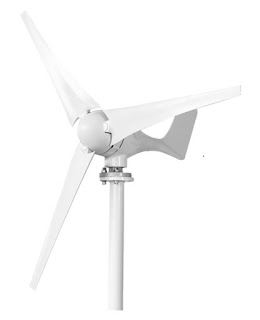The structure of a small wind power generation system is generally composed of a wind turbine, a generator, a rudder and an electrical control part. Conventional small wind turbines are mostly composed of induction generators or permanent magnet synchronous generators and AC/DC converters, batteries and inverters.
In the blowing wind, the wind wheel rotates, turning aerodynamic energy into mechanical energy. The hub of the wind wheel is fixed on the generator shaft and the rotation of the wind wheel drives the rotation of the generator shaft, driving the permanent magnet three-phase generator to generate three-phase alternating current (AC).
The wind speed changes continuously and the current and voltage generated by the generator also change accordingly. The generated electricity is rectified by the controller, is changed from alternating current (AC) to direct current (DC) with a certain voltage, make the battery charged. The direct current output from the battery pack is transformed into 220V AC after passing through the inverter, which is supplied to the user's household appliances.
According to different applications, wind turbines have two classifications, grid tie wind turbines and off grid wind turbines.
Off-grid wind turbines, also known as independent operation wind turbines, are such wind turbines used in areas without power grids and generally have relatively low power. Independently operating wind turbines generally need to be combined with batteries and other control devices to form an power generation system with independent operating wind turbine. This kind of independent operation system can be a 1 kW-90 kW to solve the power supply system of a village or it can be a small wind generator set with several hundreds of watts to solve the power supply of one household.
Due to the randomness of wind energy, the frequency and voltage of the electrical energy generated by the generator are unstable and the storage battery can only store DC electrical energy and can not directly supply power to the AC load. Therefore, in order to provide the load with stable, high-quality electrical energy and AC load power, it is necessary to add a power conversion device between the generator and the load. This power conversion device is mainly composed of a rectifier, an inverter, a controller, a battery, etc.
Most of the faults of wind turbines can be done with remote reset control and automatic reset control. The operation of the wind turbines is closely related to the quality of the power grid. In order to obtain more protection, the wind turbine is equipped with multiple protection faults, such as high and low grid voltage, high and low grid frequency, etc. which can be automatically reset.
Due to the uncontrollability of wind energy, the value of wind speed can also be reset automatically. There are also temperature limit values that can be automatically reset, such as high generator temperature, high or low gearbox temperature and low ambient temperature. Additionally, the overload fault of the wind turbine can also be reset automatically.
Except for automatic reset faults, there are other reasons about remote reset control faults. For example, there is a false alarm from the wind turbine controller, malfunctions of detection sensor. Therefore, it is necessary to have regular maintenance and inspection of small wind turbines to ensure their service life.

Comments
Post a Comment